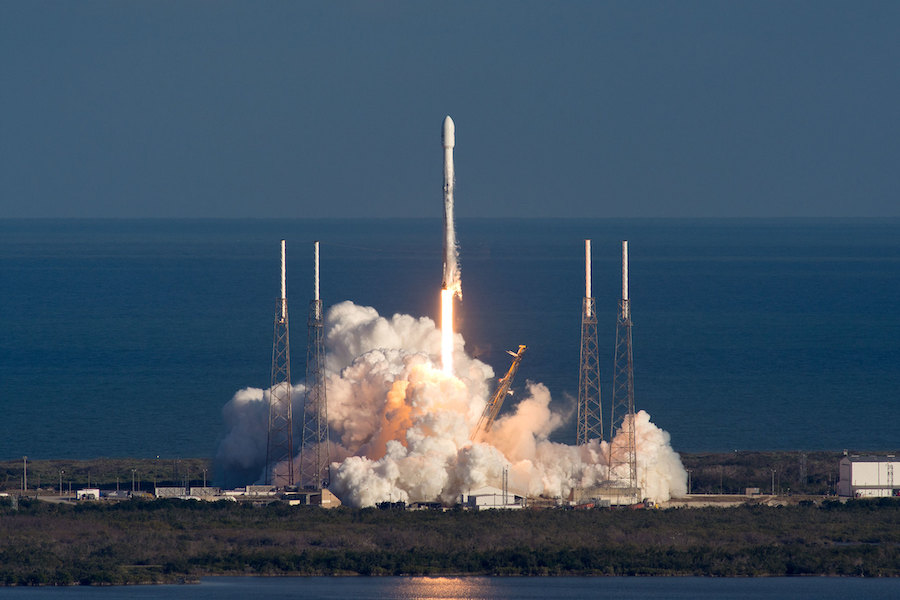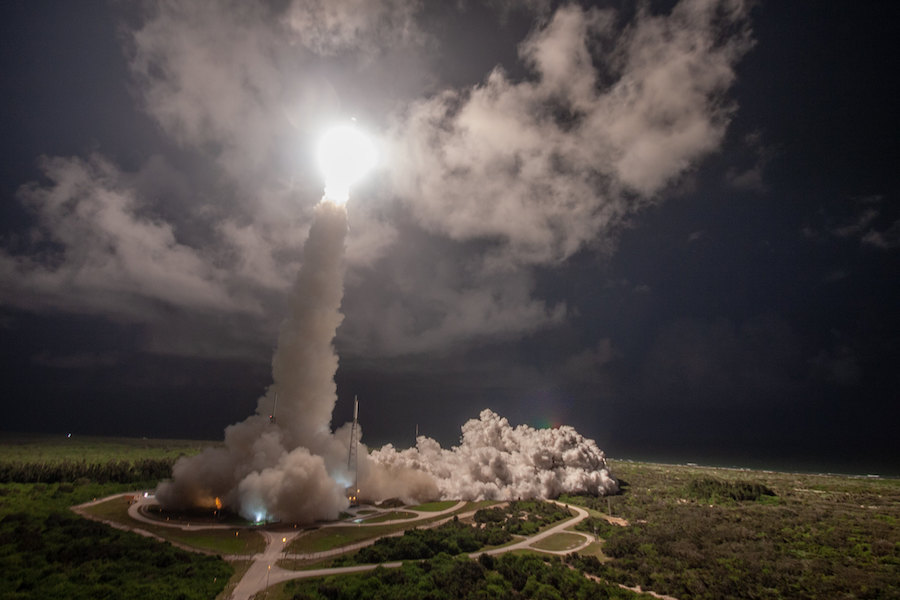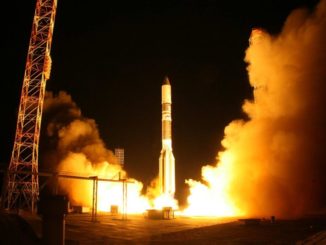
U.S. Air Force officials signed off Monday on a plan for SpaceX and United Launch Alliance, rivals in the launch services market, to fire off Falcon 9 and Atlas 5 rockets from neighboring launch pads at Cape Canaveral on Tuesday evening and Thursday morning.
The rapid-fire launch schedule will begin with the liftoff of a SpaceX Falcon 9 rocket Cape Canaveral’s Complex 40 launch pad during a window opening at 6:53 p.m. EDT (2253 GMT) Tuesday and extending until 8:21 p.m. EDT (0021 GMT).
A United Launch Alliance Atlas 5 rocket and the Air Force’s fifth Advanced Extremely High Frequency communications satellite will be sitting on pad 41, about a mile-and-a-half north of the Falcon 9 pad, when SpaceX’s rocket blasts off with the the Israeli-owned Amos 17 spacecraft.
The Air Force’s 45th Space Wing, which operates range infrastructure supporting all launches from Florida’s Space Coast, approved SpaceX’s request to reserve the range for a launch attempt Tuesday, an Air Force spokesperson said.
Brig. Gen. Doug Schiess, commander of the 45th Space Wing, told reporters Monday morning that the Air Force would likely clear the SpaceX launch to proceed Tuesday. The Falcon 9 was supposed to take off Saturday, but SpaceX delayed the launch to replace a valve and conduct a second test-firing of the rocket at pad 40.
“We believe we’re in a position, very shortly, to say that we can launch tomorrow night with SpaceX and (the Atlas 5 rocket with) Advanced EHF on Thursday morning,” Schiess said.
The Air Force confirmed the range approval Monday afternoon, setting up the Space Coast for the fastest turnaround between two orbital rocket launches since May 1981, according to a launch log tabulated by Jonathan McDowell, an astronomer at the Harvard-Smithsonian Center for Astrophysics who tracks global space activity.
A Delta rocket launched with a GOES weather satellite on May 22, 1981, followed by liftoff of an Atlas-Centaur launcher and an Intelsat communications satellites a little more than 24 hours later.
The Falcon 9 and Atlas 5 rockets are scheduled to roll out to pad 40 and 41 early Tuesday. The two launch pads, located around a mile-and-a-half from each other along the Cape Canaveral coastline, were originally built for the Air Force’s Titan rocket program.
Lockheed Martin, which operated the Atlas rocket family before the formation of ULA, took over pad 41 ahead of the first Atlas 5 launch in 2002. SpaceX leased pad 40 from the Air Force in 2007, and outfitted the seaside facility for the Falcon 9 rocket, which lifted off there for the first time in 2010.
Schiess said the Air Force might bring in additional government or contractor personnel to accommodate the quick span between launches.
The Falcon 9 and Atlas 5 launch windows open less than 35 hours apart, but finicky weather on the Space Coast could thwart the back-to-back launch plan.
There is a 60 percent chance weather conditions could prevent liftoff of the Falcon 9 rocket Tuesday evening, according to a forecast issued Monday by the Air Force’s 45th Weather Squadron. The main weather threat Tuesday is lightning.
If the Falcon 9 can’t take off Tuesday, the mission might have to wait until after the Atlas 5 mission. Schiess said Monday that the range may not be able to support a Falcon 9 launch attempt Wednesday, and still be ready for the Atlas 5’s departure Thursday morning.
There is a 70 percent chance of good weather for the Atlas 5 rocket’s two-hour window, which opens at 5:44 a.m. EDT (0944 GMT) Thursday.
Several new launch providers plan to start flying rockets from Cape Canaveral in the next few years, including Blue Origin, Firefly Aerospace and Relativity Space. With new entrants to the market joining the Cape Canaveral launch manifest, the Air Force is pushing to streamline and modernize range infrastructure on Florida’s Space Coast to support up to 48 missions per year.
That would be equivalent to an average of about one launch per week, with a few weeks of down time for maintenance on the range.
“In this case, we’d be showing that is not one a week, it’s a couple a week,” Schiess said. “We’re looking forward to it, (and) really excited to be able to show that capability.”
The Eastern Range consists of a network of communications, tracking and safety installations used by every launch from Florida’s Space Coast. The range typically operates on a first-come, first-served basis to accommodate requests from launch providers like SpaceX and ULA.
Schiess said officials from the Air Force, SpaceX and ULA discussed ways to adjust schedules to enable both companies to complete their missions this week.
“We bring them together and we see if there if there are things that we can do to massage the schedule to make it all happen,” Schiess said Monday. “That’s what’s going on over the weekend and this morning to make sure we can do all that.”

The two launches from Cape Canaveral this week are both carrying communications payloads toward operating posts in geostationary orbit more than 22,000 miles (nearly 36,000 kilometers) over the equator.
The Air Force’s Lockheed Martin-built AEHF 5 satellite riding into space aboard ULA’s Atlas 5 rocket is valued at $1.1 billion, excluding launch and operating costs, according to Don Ruffin, chief of the strategic SATCOM division at the Air Force’s Space and Missile Systems Center.
Adding the cost of the Atlas 5 launch pushes the AEHF 5 mission cost to more than $1.2 billion.
Spacecom Ltd., the Tel Aviv-based owner of commercial communications craft set for launch on the Falcon 9, says their Amos 17 mission has a total cost of around $250 million, including the cost of the Boeing-made spacecraft, launch services and insurance.
Since the 1980s, the Air Force’s Eastern Range has typically supported launches from different pads separated by at least 48 hours, with rare exceptions.
“We’ve done many many different bottleneck studies to see what we can do to enhance this,” Schiess said.
One key enabler for faster turnaround times is the introduction of an autonomous self-destruct mechanism on rockets, an addition that cuts the Air Force’s workload for each launch.
The on-board safety system relies on Global Positioning System satellite navigation data, replacing decades-old radars and tracking equipment that required military officers to manually send commands to destroy errant boosters before they could threaten people and property.
The switch is expected to save millions of dollars in infrastructure costs and allow for more launches from Air Force-run ranges at Cape Canaveral and Vandenberg Air Force Base, officials said.
Besides the range’s capability to accommodate both launches this week, Air Force officials also assessed whether the AEHF 5 satellite and its Atlas 5 launcher might be put at risk if the Falcon 9 rocket exploded soon after liftoff.
“Our safety analysts, along with … safety analysts at Aerospace Corp. and at SMC (the Air Force’s Space and Missile Systems Center), take a look at everything with the launch, and they make a determination of whether the probability of a catastrophic event happening would have some negative … impacts to AEHF,” Schiess said.
The Air Force aims to eventually host launches on the same day. The last time two orbital-class rockets blasted off from Cape Canaveral within a 24-hour period occurred in April 1978.
“We would like to get to the point where we could launch within 24 hours,” Schiess said. “We’re working toward that, to be able to do that in future endeavors, if that were to be the case.
“It would be very dependent on which launch complexes those were, and which range resources they needed, so I can’t say that 24 hours is the minimum for every different situation,” Schiess said. “It really does depend.”
United Launch Alliance booked its Atlas 5 launch with the Air Force range for Thursday before SpaceX requested a launch opportunity Tuesday. The Atlas 5 is scheduled to roll out of the Vertical Integration Facility at pad 41 around 9 a.m. EDT (1300 GMT) Tuesday and head for its launch mount on top of a mobile transporter.
“We’ve partnered with the range to be able to support (the quick launch turnaround) in any way possible,” said Gary Wentz, ULA’s vice president of government and commercial programs. “Our team has shifted to commence our roll to pad activities an hour early (Tuesday) to afford SpaceX that opportunity to launch, and de-conflict our operational activities with their’s to the maximum extent possible.”
Wentz said the early rollout will also allow ground teams to complete loading of kerosene fuel into the Atlas 5’s first stage before stormy weather is forecast to hit the Space Coast on Tuesday afternoon.
A “limited” ground crew will remain at pad 41 during SpaceX’s launch from nearby pad 40, Wentz said.
“We have the capability to keep the team safe during that operation,” he said.
Email the author.
Follow Stephen Clark on Twitter: @StephenClark1.



